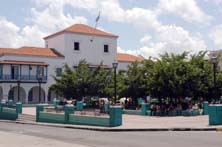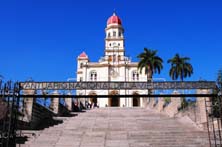Santiago de Cuba Attractions & Highlights

Parque CespedesCespedes Park
This central plaza is a major social hub of Santiago de Cuba and a spot that locals and tourists alike seem to gravitate to. Tall, leafy trees offer welcome shade from the hot sun and the benches are perfect vantage points for people-watching. Surrounding the plaza is a veritable hodgepodge of architecture, spanning the centuries from 15th-century colonial to modern 20th-century buildings. Framing the square you'll find the mansion of city founder Diego Velázquez, the cathedral, the City Hall and others.
El AyuntamientoCity Hall
The city hall, originally built in 1515, is a massive white building that, despite its 20th century renovation, retains its air of colonial elegance. It was here that Fidel Castro proclaimed, before thousands of people, the victory of the revolution on January 1, 1959.
Catedral de Nuestra Señora de la AsunciónOur Lady of Assumption Cathedral
The large, two-towered, yellow-and-white cathedral was built in the early 19th century and is the last of a series of churches - the previous edifices falling to diverse fates: pirates, earthquakes, etc. - to stand here on the edge of the Parque Cespedes. Within, you'll find spectacular frescoes covering the arches and dome and a crypt guarding the remains of Spanish conquistador and city founder Diego Velázquez.
Castillo del MorroMorro Castle
Located approximately 15 kilometers south of Santiago de Cuba is the formidable Castillo del Morro, a fortification built in 1638 to guard the Santiago Bay from pirates and other unwelcome visitors. The medieval and Renaissance-style structure, which juts out into the sea on a rocky precipice, includes 5 levels of cells, passageways, drawbridges, cannons and 1.5-meter thick walls.

Santuario del CobreSanctuary of Copper
Located 18 kilometers to the west of Santiago in the Sierra Maestra mountains - where the regions old copper mines were located - is Cuba's most important religious shrine and most famous church: the Santuatio del Cobre. Built in 1927, it houses a venerated black Madonna and protectress of Cuba: the Virgin of Charity, or Virgen de la Caridad. According to local lore, the statue was found in the early 17th century floating in the sea by a trio of fishermen. Nowadays, Cubans from throughout the country travel to the site to pay their respects to her.
Cuartel MoncadaMoncada Barracks
In 1953, a group of revolutionaries - led by Fidel Castro, Raúl Castro and Che Guevara - attacked these barracks, hoping to capture it and seize the weapons within. Their attempt was successful and many were jailed for it, but it gained recognition for them and their cause and is considered the first big event in the revolutionary path that ended with Fidel Castro proclaiming the success of the Revolution in 1959 and assuming power. Within there is a small museum - the Museo Histórico 26 de Julio - that covers Cuba's history since the 1950's, but naturally pays a bit of special attention to the decade of the 1950's.



